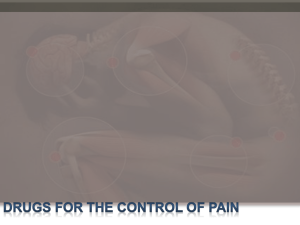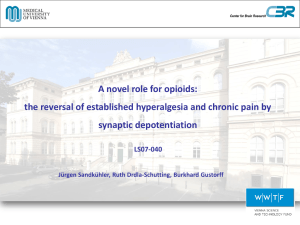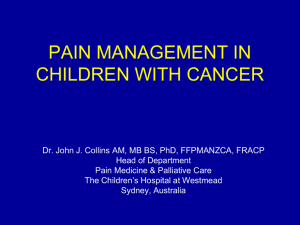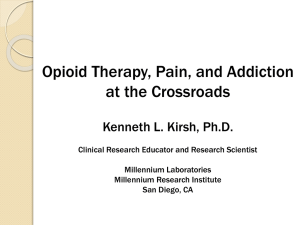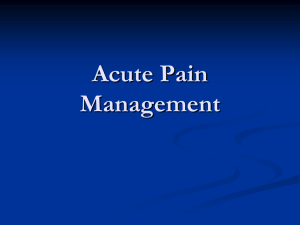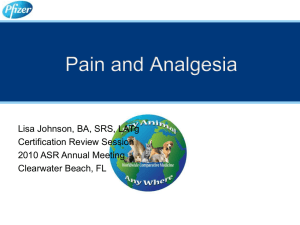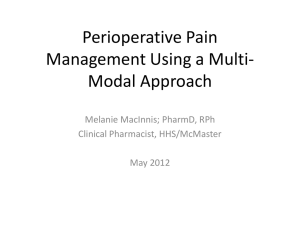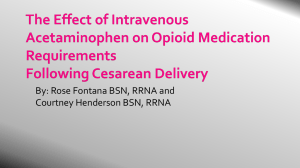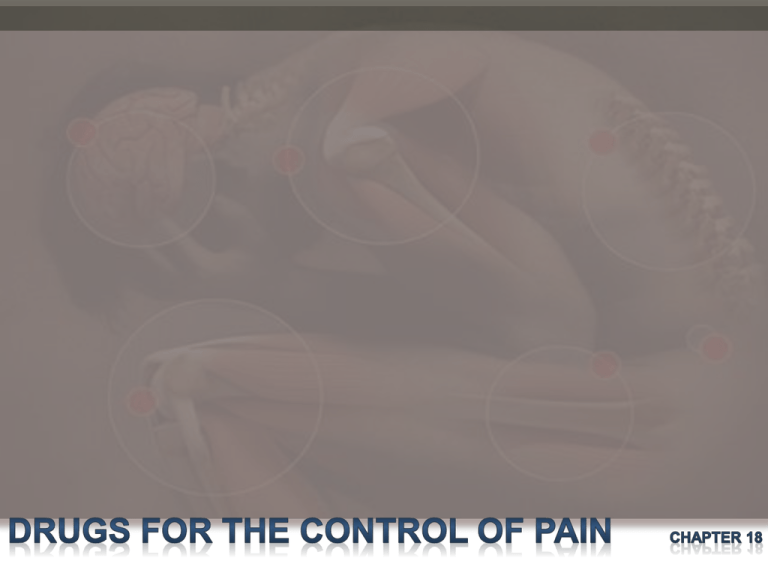
OVERVIEW:
Neuro System
Opioids
Salicylates
NSAIDs
Non-Opioid
Antidepressant /
Anxiolytic
Benzodiazepines
lorazepam (Ativan)
diazepam (Valium)
GABA
A
Antagonist
zolpidem (Ambien)
aspirin (ASA)
ibuprofen (Motrin)
acetaminophen (Tylenol)
tramadol (Ultram)
Anti-Migraine
ergotamine (Cafergot)
Sumatriptan (Imitrex)
escitalopram (Lexapro)
MAOIs
morphine (Infumorph)
Central Acting
Tri-Cyclic
Antidepressa
nt
Opioid
Antagonists
naloxone (Narcan)
Phenytoin-Like
Drugs
phenytoin (Dilantin)
valproic acid (Depakote)
Succinimides
ethosuximide (Zarontin)
Barbiturates
phenobarbital (Luminal)
Phenothiazines
chlorpromazine (Thorazine)
NonPhenothiazines
halperidol (Haldol)
Atypical
Antipsychotics
risperidone (Risperdal)
Pain Assessment
• Subjective experience for clients
• Numerical scales and surveys assist in assessment.
• Effective pharmacotherapy depends on
• Assessment of degree of pain
• Determining underlying disorders
Acute Pain
• Intense
• Defined period of time
Chronic Pain
• Over six months’ duration
• Interferes with daily activities
Nociceptive Pain
• Due to injury to tissues
• Sharp, localized
• Dull, throbbing, aching
Neuropathic Pain
• Due to injury to nerves
• Burning, shooting, numbing
Pain Transmission
• Nociceptor stimulation
• Spinal cord receives pain impulse through
• ∂ fibers – believed to signal sharp, well-defined pain
• C fibers – believed to conduct dull, poorly localized pain
Endogenous Opioids
• May modify sensory information, interrupting pain
transmission
• Endorphins, dynorphins, ekaphalins
Interruption of
Pain Transmission
• Several target areas
• Peripheral level
• CNS level
• Pharmacological
• Nonpharmacological
Nonpharmacologic Techniques for Pain
Management
• Used alone or in conjunction with pharmacotherapy
• May allow for lower doses and possibly fewer drug-related
adverse effects
Nonpharmacological Therapies
• Acupuncture
• Biofeedback
• Massage; therapeutic or physical touch
• Heat or cold
• Meditation or prayer
• Relaxation
• Art or music therapy
• Chiropractic manipulation
• Hypnosis
• TENS
• Energy therapies such a Reiki and Qi gong
Treatment for Intractable
Cancer Pain
• Radiation or chemotherapy
• Relieving nerve stimulation
• Surgery
• Nerve block
Opioids
A natural or synthetic
morphine-like substance
responsible for reducing
moderate to severe pain
Opioid Receptors
• Receptors: mu, kappa, sigma, delta, epsilon
• For pain management mu and kappa receptors are most important
• Opioid agonist drugs: stimulate receptors
• Opioid antagonist drugs: block receptors
Figure 18.2 Opioid receptors
Opioid Antagonists
• Block opioid activity
• Compete for opioid receptor
• Reverse symptoms of addiction, toxicity, and
overdose
• Naxalone (Narcan) may be used to reverse respiratory
depression and other acute symptoms
• Also used to diagnose overdose
Opioid Dependence
• Potential to cause physical and psychologic
dependence
• Patient-controlled analgesia (PCA)
• Combinations with nonnarcotic analgesics
Treatment for
Opioid Dependence
• Switch from IV and inhalation forms to methadone,
the oral form
• Methadone maintenance
• Does not cure but avoids withdrawal symptoms
• Treatment may continue for many months and years
Newer Treatment
• Early treatment: buprenorphine (Subutex)
• Mixed opioid agonist-antagonist
• Sublingual route
• Later maintenance: Suboxone
Role of Nurse
• Careful monitoring of client’s condition
• Providing education
• Obtaining medical history
• Obtaining list of allergies
• Assessing client’s pain level
• Obtaining history of medications and alcohol and CNS-
depressant use
Opioid Therapy
• Assess potential for opioid dependency
• Have narcotic antagonists available to reverse negative
effects
• Assist with activity
• Monitor urine output for retention
• Monitor client’s bowel habits for constipation
Opioid Antagonist Therapy
• Continue careful monitoring of client’s condition
• Especially respiratory status
• Have resuscitative equipment available
Nonopioid Analgesics
• Careful monitoring of client’s condition and
providing education is necessary
• Thorough assessment for hypersensitivity,
bleeding disorders
• Through assessment for gastric ulcers, severe
renal/hepatic disease, pregnancy
Nonopioid Analgesics (continued)
• Obtain laboratory tests on renal and liver
function
• Pain assessment
• Monitor for side effects
Opioid (Narcotic) Analgesic
Opioid agonists (morphine)
• Mechanism of action: interacts with mu and
kappa receptor sites
• Primary use: for analgesia and anesthesia
• Adverse effects: respiratory depression,
sedation, nausea, and vomiting
• Prototype drug:
Table 18.2 (continued)
Opiods for Pain Management
Morphine Animation
Click here to view an animation on the topic of morphine.
Opioid Antagonists
naloxone (Narcan)
• Mechanism of action: interact with
receptors
• Primary use: to reverse respiratory
depression and other acute symptoms of
• Prototype drug:
opioid addiction, toxicity, overdose
Opioids with Mixed Agonist-Antagonist
Activity
• Example: Talwin
• Stimulate opioid receptor, thus causing analgesia
• Withdrawal symptoms and side effects not as
intense as those of opioid agonists
Salicylates
aspirin (ASA)
• Mechanism of action: as anticoagulant,
antipyretic, anti-inflammatory, and analgesic
• Adverse effects: with high doses may cause
GI distress and bleeding
• May increase action of oral hypoglycemic
agents
• Prototype drug:
Nonsteroidal Anti-inflammatory Drugs
(NSAIDs)
• Prototype drug: ibuprofen (Motrin)
• Mechanism of action: to inhibit cyclooxygenase
and prevent formation of prostaglandins
• Primary use: for mild or moderate pain and to
reduce inflammation
• Adverse effects: GI upset, acute renal failure
Selective Cox-2 Inhibitors
• Prototype drug: celecoxib (Celebrex)
• Mechanism of action: is similar to the NSAIDs
• Primary use: to relieve pain, fever, inflammation
• Adverse effects: mild and related to GI system
Nonopioid Analgesics
• Prototype drug: acetaminophen (Tylenol)
• Mechanism of action: to treat fever: at the level
of the hypothalamus and causes dilation of
peripheral blood vessels enabling sweating and
dissipation of heat
• Primary use: treatment of fever and to relieve
pain
• Adverse effects: uncommon with therapeutic
doses
Acetaminophen Animation
Click here to view an animation on the topic of acetaminophen.
Table 18.3 (continued)
Nonopioid Analgesics
Centrally Acting Agents
• Prototype drug: tramadol (Ultram)
• Mechanism of action: has weak opioid activity
• Primary use: as centrally acting analgesic
• Adverse effects can include: CNS, GI, CV and
dermatologic effects
Ergot Alkaloids
• Mechanism of action: to promote vasoconstriction
• Primary use: to terminate ongoing migraines
• Adverse effects: GI upset, weakness in the legs,
myalgia, numbness and tingling in fingers and toes,
angina-like pain, tachycardia
Triptans
• Prototype drug: sumatriptan (Imitrex)
• Mechanism of action: to act as serotonin
agonists, constricting certain intracranial vessels
• Primary use: to abort migraines with or without
auras
• Adverse effects: GI upset
Table 18.4 (continued) Antimigraine Drugs
Opioid Agonists
• Mechanism of action: to interact with specific
receptors
• Primary use: to relieve moderate to severe pain;
some used for anesthesia
• Examples: OxyContin, Percocet
Opiod Antangonists
• Blockers of opioid activity
• Used to reverse symptoms of opioid addiction, toxicity,
overdose
• Examples: Revex, Narcan, Trexan
Nonopioid Analgesics
• Used for fever, inflammation, and analgesia
• Used for mild or moderate pain associated
with inflammation
• Examples: Celebrex, Cataflam, Dolobid,
Lodine, Nalfon
Antimigraine Agents
• Triptans
• Serotonin agonists
• Act by constricting certain intracranial vessels
• Ergot alkaloids
• Serotonin agonists
• Act as vasoconstrictors
• Terminate ongoing migraines
• Migranal, Axert, Relpax, Frova
NCLEX-RN Review
Question 1
The nurse teaches the patient relaxation techniques and
guided imagery as an adjunct to medication for treatment of
pain. The nurse explains that the major benefit of these
techniques is that they:
1.
2.
3.
4.
Are less costly
Allow lower doses of drugs
with fewer side effects
Can be used at home
Do not require self-injection
NCLEX-RN Review
Question 1 – Answer
1.
2.
3.
4.
Are less costly
Allow lower doses of drugs with fewer side effects
Can be used at home
Do not require self-injection
NCLEX-RN Review
Question 1 – Rationale
Rationale: When used concurrently with
medication, nonpharmacologic techniques may
allow for lower doses and possibly fewer drugrelated adverse effects. Relaxation techniques
and imagery may also be used in the acute
care setting.
NCLEX-RN Review
Question 2
The nurse recognizes that opioid analgesics exert their
action by interacting with a variety of opioid receptors.
Drugs such as morphine act by:
1.
2.
3.
4.
Activating kappa and blocking mu receptors
Inhibiting mu and kappa receptors
Activating mu and kappa receptors
Blocking sigma and delta receptors
NCLEX-RN Review
Question 2 – Answer
1.
2.
3.
4.
Activating kappa and blocking mu receptors
Inhibiting mu and kappa receptors
Activating mu and kappa receptors
Blocking sigma and delta receptors
NCLEX-RN Review
Question 2 – Rationale
Rationale: Some opioid agonists, such as morphine,
activate both mu and kappa receptors.
NCLEX-RN Review
Question 3
A patient admitted with hepatitis B is prescribed Vicodin 2
tablets for pain. The appropriate nursing action is to:
1.
2.
3.
4.
Administer the drug as ordered
Administer 1 tablet only
Recheck the order with the health care
provider
Hold the drug until the health care provider
arrives
NCLEX-RN Review
Question 3 – Answer
1.
2.
3.
4.
Administer the drug as ordered
Administer 1 tablet only
Recheck the order with the health care provider
Hold the drug until the health care provider arrives
NCLEX-RN Review
Question 3 – Rationale
Rationale: Vicodin is a combination drug of
hydrocodone and acetaminophen.
Acetaminophen can be hepatotoxic, and this
patient has hepatitis B, a chronic liver disorder.
NCLEX-RN Review
Question 5
Nursing interventions for a patient receiving opioid
analgesics over an extended period should include:
1.
2.
3.
4.
Referring the patient to a drug treatment
center
Encouraging increased fluids and fiber in
the diet
Monitoring for GI bleeding
Teaching the patient to self-assess blood
pressure
NCLEX-RN Review
Question 5 – Answer
1.
2.
3.
4.
Referring the patient to a drug treatment center
Encouraging increased fluids and fiber in the diet
Monitoring for GI bleeding
Teaching the patient to self-assess blood pressure
NCLEX-RN Review
Question 5 – Rationale
Rationale: Opioids suppress intestinal contractility,
increase anal sphincter tone, and inhibit fluids into the
intestines, which can lead to constipation.
NCLEX-RN Review
Question 6
The most appropriate method to ensure adequate pain
relief in the immediate postoperative period from an opioid
drug would be to:
1.
2.
3.
4.
Give the drug only when the family members report
that the patient is complaining of pain.
Give the drug every time the patient complains of
acute pain.
Give the drug as consistently as possible for the first
24 to 48 hours.
Give the drug only when the nurse observes signs
and symptoms of pain.
NCLEX-RN Review
Question 6 – Answer
1.
2.
3.
4.
Give the drug only when the family members report that
the patient is complaining of pain.
Give the drug every time the patient complains of acute
pain.
Give the drug as consistently as possible for the
first 24 to 48 hours.
Give the drug only when the nurse observes signs and
symptoms of pain.
NCLEX-RN Review
Question 6 – Rationale
Rationale: Opioid pain relievers should be given as consistently as
possible, and before the onset of acute pain, in the immediate
postoperative period unless the patient’s condition does not allow the
consistent dosing (e.g., vital signs do not support regular doses).
Giving the drug only when the family members report that the patient is
complaining of pain, every time the patient complains of acute pain, or
only when the nurse observes signs and symptoms of pain. These
methods of drug administration would potentially allow pain to become
severe before being adequately treated. Patients or family members may
not always report pain or may downplay the severity.
Cultural norms may also influence the patient’s way of exhibiting pain.
Drugs for Control of Pain
• Assessment
• Carefully monitor client’s condition
• Assess vital signs, especially respiratory status
• Assess client’s pain level: character, duration, location, intensity of
pain
• Obtain history of medications, alcohol use
Drugs for Control of Pain (continued)
• Assessment
• Obtain medical history and history of migraine headaches
• Assess client’s stress levels and coping mechanisms
• Monitor for side effects and potential for dependency
Drugs for Control of Pain (continued)
• Nursing diagnosis
• Knowledge deficit—condition, therapeutic regimen, side effects
• Risk for dependency related to opioid therapy
Drugs for Control of Pain (continued)
• Planning
• Goal is to explain proper use of medication
• Client to be free of pain without dependency
Drugs for Control of Pain (continued)
• Implementation
• Encourage compliance with medication regimen
• Provide additional education
Drugs for Control of Pain (continued)
• Evaluation
• Client should have pain control with limited side effects, no
dependency.
• Client verbalizes importance of taking prescribed medications.

